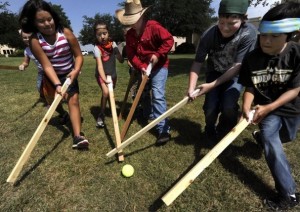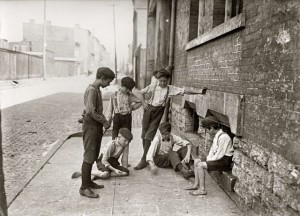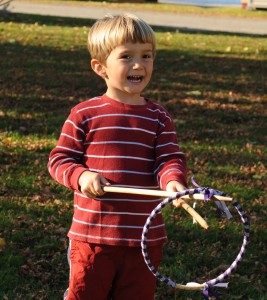 As educators, we’re always looking for ways to make museum content “stickier” and more meaningful. Sometimes we’re overlooking a powerful and universal human tool: games.
As educators, we’re always looking for ways to make museum content “stickier” and more meaningful. Sometimes we’re overlooking a powerful and universal human tool: games.
Games have a very long history as teaching techniques. Through fun and competition in a rule-bound environment, humans have improved their skills and performance on important tasks through the enjoyable challenge and practice of games.
From the earliest matching of colors and shapes in a game of Memory to the most cutting-edge Augmented Reality experience, games provide intrinsically rewarding ways to test yourself, take on alternative roles and points of view, compete or collaborate, make decisions and experience consequences. Game-Based Learning is a hot topic in the educational conversation today.
It might seem that you need expensive technology to teach with games, but that’s not true. Even the most sophisticated virtual games are simply updates of the same basic ideas that have always been part of structured play experiences.What kinds of simple game structures work well in museum learning?
Roleplaying Games: Taking on a role can create a powerful empathetic experience and give insight into what happens when different points of view collide. Roleplaying games can be very simple or fearsomely complex when variables of character qualities , goals, obstacles, and novel situations are factored in (think of all the elements of the computer-based roleplaying simulation, Oregon Trail, or of a Dungeons and Dragons game).
But roleplaying games need not always be complicated. On a recent visit to the Boston Tea Party Museum, a commercial museum that takes visitors through a retelling of the events around this famous act of protest, I was handed a “role card” as I entered. In under 100 words, the card gave my name, occupation, my interest in taxation issues, and a cue for me to speak a short line or do an action later on in the visit. What a simple way to ensure my attention – I wasn’t going to tune out when I didn’t know my cue was going to come up! The Noah Webster House and West Hartford Historical Society uses a similar tactic in their Human Rights Roleplay program. NOTE : Roleplaying can sometimes be very serious, as real issues from human lives are raised. Sometimes “game” might not be the word to use; “experience” or “simulation” can be a more respectful choice so as not to suggest past challenges were always fun.
Action Games: The environmental education organization Project Wild has been developing action-based games to teach natural science concepts since 1983. Suitable for playing in outdoor spaces or large indoor halls, these games often rely on actions like running back and forth into new boundary areas, collecting items, and navigating obstacles. Instructors create a physical space with very simple materials, like poker chips, lengths of rope, and paper plates, and use students’ powers of imagination to redefine them as resources like food or water, and constraints like space or predatation. Games like this are excellent at illustrating cycles, events that occur in sequence, and ideas like competition for resources. These game structures can often be applied to work for historical topics – for instance, while at Mystic Seaport, I adapted a fishing game in which students played fishing vessels, had a short “season” to gather “fish” represented by a collection of different-sized balls, and had to operate on different constraints each season. That helped students trace  and understand the reasons for changes in the historical regulation of fisheries that came with changes in the fishing technology we demonstrated on the historic vessels, and helped students realize how difficult fisheries management is and why it’s still a matter of debate.
and understand the reasons for changes in the historical regulation of fisheries that came with changes in the fishing technology we demonstrated on the historic vessels, and helped students realize how difficult fisheries management is and why it’s still a matter of debate.
Tabletop Games: Board games, card games, dice games, tile games, and even paper-and-pencil games can create a context for history learning. Building on existing game types, content and imagery can be adapted to local content and topics.
Parlor Games/Social Games: Some games require only people. Both period games like these Victorian parlor games, and modern games that use words, motions, questions and answers (like 20 Questions) and other activities are great ways to lend a sense of fun, learn and share names, break the ice, or introduce a thematic topic. Games from the long history of street play – like handclapping games, hopscotch, foursquare, or running bases, are also social and simple to present.
Period Games: Bring a historical moment to life by  enjoying the games of the time. At Strawbery Banke, red baskets in each period house contain popular toys and games from the time — a set of marbles in the 1950s Shapley-Drisco House, a Shut the Box board in the Colonial tavern. Did you know that Scrabble was partially inspired by the 1920s craze for all things crossword? Period games are a fun way to learn about the material culture and leisure time activities of days past.
enjoying the games of the time. At Strawbery Banke, red baskets in each period house contain popular toys and games from the time — a set of marbles in the 1950s Shapley-Drisco House, a Shut the Box board in the Colonial tavern. Did you know that Scrabble was partially inspired by the 1920s craze for all things crossword? Period games are a fun way to learn about the material culture and leisure time activities of days past.
Games and gaming are enormously important topics in contemporary education. As more experimentation goes on at the forefront of technology, history educators should pay attention to the opportunities afforded by digital gaming, and think about how our site experiences will eventually make use of that.
But we don’t have to wait for the technology to trickle down before we take advantage of the extraordinarily compelling power of games, even using the simplest materials paired with fascinating ideas about the past.
Have you used games in teaching ? What kinds of games are built into your programs or available in your interpretation?




